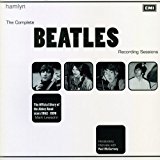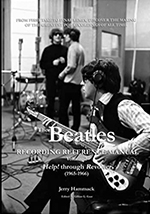- Album Songs recorded during this session officially appear on the Paperback Writer / Rain (UK) 7" Single.
- Studio:
- EMI Studios, Studio Two, Abbey Road
Some songs from this session appear on:
Spread the love! If you like what you are seeing, share it on social networks and let others know about The Paul McCartney Project.
About
This was the seventh day of the recording sessions for the “Revolver” album. During that 11-hours long session (from 2:30 pm to 1:30 am), The Beatles completed “Rain“, started two days before and which would be released as the B-Side of their next single.
On this day, they added more overdubs onto take 5. Paul McCartney added his bass part and Ringo Starr a tambourine part, before three reduction mixes (labelled takes 6 to 8) were done to free up a track.
Paul, George Harrison and John Lennon then added their harmony vocals onto take 7. John decided to add some of his vocals played backwards at the end of the song ; this was added onto take 7 as well.
I used the same bass sound on it, but it’s a recording that is largely distinguished by a creative accident brought about by John’s technical ineptitude. Because he and the other three Beatles owned Brenell recorders, they were able to take open-reel tapes home with them whenever they wanted to listen to works in progress.
The afternoon we recorded the backing track and vocal to “Rain,” John asked for a rough mix and Phil dutifully ran a copy off for him. But when he got home that night, Lennon mistakenly threaded the tape backward on his machine. Not understanding that the problem was of his making, he thought that Phil had somehow gotten it wrong. Fortunately for Phil, John liked what he was hearing.
The next day, John marched into the control room, tape in hand, and demanded that we all listen to his “incredible” discovery. George Martin tried to explain what had happened, but the ever-impatient Lennon didn’t care. All he knew was that this was the sound he wanted for the song’s fadeout and he was off to have a cuppa; getting it accomplished was our job. So George had me copy the track of John’s singing the last verse onto our two-track machine. I then instructed Phil to turn the copy over so it would play backwards, and we flew it into the multitrack at the proper spot. Lennon was thrilled with the result. From that point on, the Beatles got backwards fever: almost every overdub we did on Revolver had to be tried backwards as well as forwards. […]
Geoff Emerick – From “Here, There and Everywhere: My Life Recording the Music of The Beatles“, 2006
It was the first time that we had used a backward voice on a track. This is a song I wrote about people who are always moaning about the weather all the time, you know, whatever it is, it’s OK, it’s meant to be. I went home at about three o’clock in the morning, and in those days we used to take a seven-and-a-half-inch tape cut of a track home and, by the next night, arrange what we were going to put on top of it, you know. Whoever’s song it was, it was their responsibility. The next night I went home and I was out of my mind, stoned, because we had been working till five in the morning. I got home at about six in the morning, stuck the tape on, stuck it on backwards and played ‘Rain’ and it came out backwards. I had my headphones on, and I was thinking, ‘Wow, this is a fantastic.’ So the next day, I went in and I said, ‘What about the end of the song? Why don’t we have the whole of the song again, you know, backwards? We didn’t do that, but we just laid my voice track and guitar track over the last half-minute backwards. You can hear it at the end. It sounds as if I’m singing Indian.
John Lennon – From “The Beatles: Off The Record” by Keith Badman, 2008
“He didn’t do that,” Martin told me when I quoted John’s discovery story. “I can tell you — I created that. I actually suggested we try to turn this round and when he was out I actually lifted off the voice track, turned it back, slid it around until I found a good spot, and played it to him when he came back. He fell over the floor. He thought it was great.” Martin pointed out to me that he’d “been experimenting with tapes for years before the Beatles ever came along,” citing his 1962 single “Time Beat,” which he recorded with the BBC Radiophonic Workshop under the name Ray Cathode.
From “Beatles ’66: The Revolutionary Year” by Steve Turner
The closing words are recorded just as an in-joke. The Beatles weren’t quite sure what to do at that point, so I took out a bit of John’s voice from earlier on and played it backwards. They all thought it was marvellous. It had a sort of unexpectedly eastern sound, so we kept it in. We often like to do things like that for a giggle, particularly as they so often work out.
George Martin – From “The Beatles: Off The Record” by Keith Badman, 2008
Four mono mixes were created at the end of the session, all four with varying degrees of ADT (Artificial Double Tracking) applied to John’s lead vocals. Remix Mono 3 was chosen to become the released version on the next single.
“Rain” would be mixed in stereo 3 years later, on December 2, 1969, for inclusion on the US compilation “Hey Jude“.
Last updated on December 1, 2023
Songs recorded
7.
Mixing • Mono mixing - Remix 3 from take 7
Album Officially released on Paperback Writer / Rain (UK)
Staff
Musicians on "Rain"
- Paul McCartney:
- Backing vocals, Bass
- Ringo Starr:
- Tambourine
- John Lennon:
- Backing vocals
- George Harrison:
- Backing vocals
Production staff
Going further
The Complete Beatles Recording Sessions • Mark Lewisohn
The definitive guide for every Beatles recording sessions from 1962 to 1970.
We owe a lot to Mark Lewisohn for the creation of those session pages, but you really have to buy this book to get all the details - the number of takes for each song, who contributed what, a description of the context and how each session went, various photographies... And an introductory interview with Paul McCartney!
The Beatles Recording Reference Manual - Volume 2 - Help! through Revolver (1965-1966)
The second book of the Association for Recorded Sound Collections (ARSC)-nominated series, "The Beatles Recording Reference Manual: Volume 2: Help! through Revolver (1965-1966)" follows the evolution of the band from the end of Beatlemania with "Help!" through the introspection of "Rubber Soul" up to the sonic revolution of "Revolver". From the first take to the final remix, discover the making of the greatest recordings of all time.
Through extensive, fully-documented research, these books fill an important gap left by all other Beatles books published to date and provide a unique view into the recordings of the world's most successful pop music act.
If we like to think, in all modesty, that the Paul McCartney Project is the best online ressource for everything Paul McCartney, The Beatles Bible is for sure the definitive online site focused on the Beatles. There are obviously some overlap in terms of content between the two sites, but also some major differences in terms of approach.




Contribute!
Have you spotted an error on the page? Do you want to suggest new content? Or do you simply want to leave a comment ? Please use the form below!